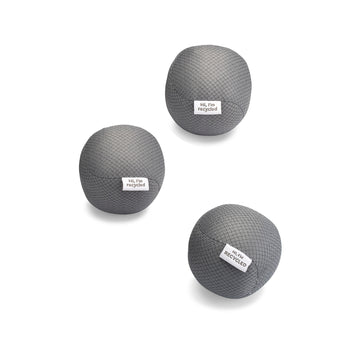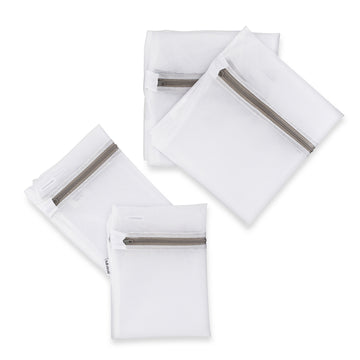Planet-Loving Laundry Tips & Tricks
Is there anything better than fresh-out-of-the-dryer clothes, towels, and bedding? How about proper washing techniques that allow you to extend the lives of your favorite textiles? For as much time as we spend doing laundry, few of us actually wash and dry as we should. Because sustainability means keeping clothes in circulation longer by taking better care of them, we’ve put together some tried and true laundry tips and tricks.
You Might Be Doing Laundry Wrong
Whether you’re using practices that have been passed down for generations or just shove everything in the washer and dryer and hope for the best, the reality is that few of us are doing laundry properly. You’d think that our cumulative 35 billion loads a year would instill in us some best practices—but many of us are using too much detergent, overstuffing the machine, using the washer or dryer too long, or forgetting the importance of sorting.
Fortunately many of the common laundry errors are also easily fixable. Let’s take a look at how we can optimize our laundry day to help support our planet.
When to Wash What?
Yes, we’re washing things wrong. However, we can all let out a big sigh of relief to know that we can actually wash certain things less often. Here’s how we can begin to simplify our laundry days.
Items to be washed after every wear/use:
- Socks
- Underwear
- Activewear
- Sports bras
- Tights
- Blouses
- Shirts
- Wash cloths
- Dish and hand towels
Items to be washed after three wears:
- Bras and camisoles
- Dresses
- Skirts
- Dress pants
- Pajamas
- Bath towels
Items to be washed every week:
- Jeans
- Sweaters (if worn with an undershirt)
- Blazers and suits
- Pillowcases
- Sheets
Items to be washed every month:
- Bathrobe
- Mattress pad and pillow liners
This is the optimum balance for helping to keep bacteria at bay and extending the life of your most-loved clothes. Every wash takes a toll on the fabrics and threads, so minimizing washing is one of the best things we can do for our wardrobe. In between washes you can always use a steamer to freshen things up and remove any post-wear wrinkles.
Sorting, Organizing, Optimizing
Now that we know that we can wash less, here’s how we can wash better—and it all starts with properly sorted clothes.
It’s a cliché laundry mishap, and one that many of us have fallen victim to: mixing whites and colors. The suggestion for washing darks and lights separately is there for a reason, even if it may take some time before you notice a tinge of color on a white tee.
A laundry hamper system that allows you to separate these two from the get-go can make things easier. Once you lug everything down to the laundry room, you likely won’t want to spend time sifting, so if you can do so beforehand, it makes laundry day a little easier.
You can take your laundry load organization to the next level by making use of wash bags.
How to Use Wash Bags
Wash bags make sorting easier, and they can also help to protect your clothes—and our planet. They prevent snagging and keep heavier items with hardware (zippers, buckles, clasps, hooks, buttons) away from other clothes they may damage. Also perfect for activewear or delicates, wash bags also help to preserve elasticity, extending the life of your well-loved leggings.
Since roughly 60% of our clothes are made from synthetic (plastic-based) fibers like polyester and nylon, using a larger wash bag for activewear can help to wash them more gently, therefore reducing the release of microplastics.
When it comes to how to use a laundry wash bag, the process is simple:
- Have your wash bags near your hamper system to presort as you wear.
- Keep matching linens together (i.e. activewear in a large wash bag, delicates in a small wash bag).
- Be sure to tuck away any zippers and fasten all hooks and closures.
- Fill the wash bag just halfway to allow clothes to move during a wash.
- Zip the wash bag and place in the washer.
- Take the bag out of the washer, and if needed, toss in the dryer.
Is it Getting Hot in Here?
Speaking of drying, let’s talk about the biggest environmental impact of each laundry day: heat. Heating the water can account for about 90% of the total energy of the washer. Worse, hot water can break down fibers and more quickly ruin synthetic fabrics. It can shrink natural fabrics, and even cause bright colors to fade.
The memo to wash with cold has been spread far and wide, so now most detergents have been adapted to work well in cooler temperatures. That said, there’s really no reason not to wash in cold water.
While it’s a little trickier, avoiding the dryer can have even more of a positive impact. Studies have found that around 75% of the carbon footprint of laundry comes from drying. This is because a dryer uses electricity to generate heat, which is one of the least efficient ways it can do so.
Enter line drying: a planet-loving laundry practice. By switching to a washing line or clothes rack, a typical household using the dryer 200 times a year could reduce their impact by a whopping half a tonne of CO2! Even better, your clothes will smell fresher and experience less wear-and-tear.
You Can Still Hate Laundry Day But Love Your Laundry
The mismatched socks and dirty sports uniforms that make it into each load have been made using valuable resources, so the least we can do is try to show them a little love so that they last longer. Hopefully this list helps you realize that doing so can actually make your life a little easier when each laundry day comes around.
By washing clothes only when they need it, doing a bit of proactive sorting, and reducing heat requirements as much as possible, you can help take the load off our planet.






